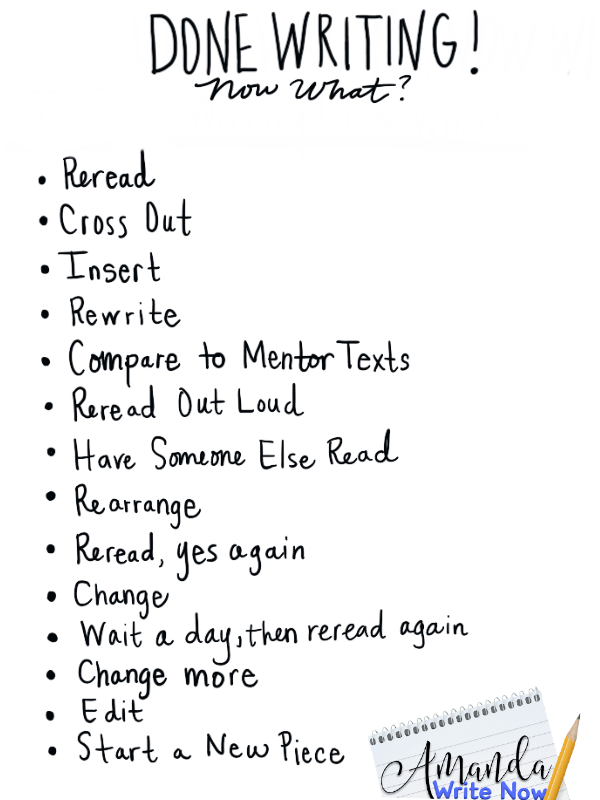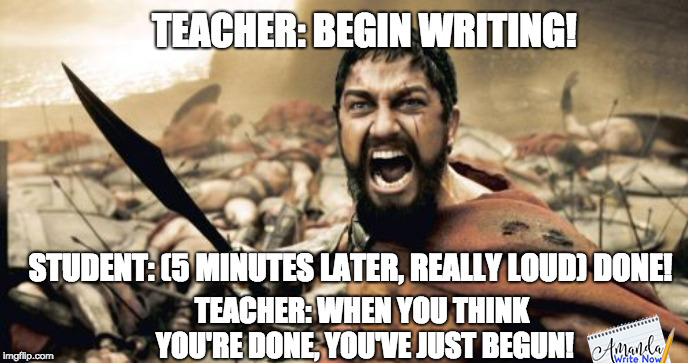
Teaching writing is so hard! There are many reasons why, but one of the main reasons is distracting student behavior! With a plan in place, your ability to handle the distracting student behavior can improve.
No matter what though, it is important to realize that students are people who don’t necessarily value what you, the teacher, values. For most students, writing is just not a priority. So, it’s our job to approach students positively, to convince them of the value of writing and support them in finding ways to focus.
Not every strategy works for every student. My advice is to try one strategy and if that doesn’t work, try another and then another. Remember all teaching and learning is a work in progress!
1. Pretending to Work
The Scenario
If you’ve been a teacher for any length of time you’ve definitely experienced the student who pretends to work. They pick up their pencil when you walk near and put it down as soon as you make the slightest movement away. This is definitely an annoying and distracting student behavior!
It’s almost as if they are only capable of work if you are sitting right next to them and with 30+students this is not possible.
There are a number of things that could be going on with this student. One reason they might have a difficult time doing their work when you’re not around is that they are a social butterfly. This is pretty typical, kids are super social, which is a good thing and perfectly normal, age-appropriate behavior.
Another reason they may not be able to work when you aren’t around is because they are struggling and don’t want others to know they aren’t sure what the heck is going on! The third reason might be they just don’t care.
What to Do About It?
Below you’ll find a list of strategies to use with the pretender. Use the strategies in combination or try one and if it doesn’t work, then try another. This distracting student behavior can be remedied with some tweaks by either you, the student or even better with both of you working together.
- Have a one-on-one conversation with the student.
- Ask how you can help. Sometimes kindness really does kill annoying behaviors.
- Break the writing task down into smaller chunks.
- Tell the student you will check back in with them after five minutes to see how far they’ve gotten on the small chunk.
- Draw a line on the students’ paper and tell them you want to see that they get there when you come by again in five-ten minutes.
- Define/show what productive looks like.
- Explain the options…continue sitting with your peers or move away to a place where they can better focus.
If you have strategies that work for the pretender, I’d love to hear about them! Join the Writing Workshop Inspiration for Upper Grades Facebook Group and share your knowledge with over 600 other writing teachers.

2. Talking Too Loud
The Scenario
Some students talk really loud and aren’t aware of it. Some talk really loud and are fully aware of what they are doing. I actually have a couple boys in my class who like to say, “God Bless You [insert name of student who sneezed]!” in a very dramatic and loud way anytime they hear someone sneeze during silent work time. These students know exactly what they are doing.
What to Do About It?
The way you approach this student is different depending on if they are purposefully talking too loud to get everyone else off task or if they don’t mean to, they are just oblivious or super excited. Here are some strategies for both…
Talking Loud on Purpose…
- Have a one-on-one conversation with the student.
- Say, “Hey, I’m here. You seem like you need some attention”, in the kindest way possible. Seriously, kindness and calling a student out can really help:)
Talking Loud by Accident
- Have the student practice different noise levels with you.
- Model a whisper voice.
- Make eye contact with the student and use hand gestures. The hand gestures could be secret signals between you and the student to help them better recognize when they are talking a little too loud.
3. Asking for Help with EVERYTHING
The Scenario
We all know these students. They are the ones we spend a whole lot of time with because they are always asking for help. Hey! At least they care, we tell ourselves. But, soon all the questions and support these students need gets overbearing. Asking for help is a great skill to have but asking for help constantly is not and can really tire a teacher out. Here are some things you can do…
What to Do About It?
- Ask the student if there are any peers they trust to go to for help.
- Explain to the whole class that you are not the only teacher in the room and that you expect that each writer supports others.
- Tell the student to Google their question. Seriously, Google is pretty smart.
- Explain the situation, you are one teacher and there are 30+ students in the room. You have to help others too!
- Teach writing self-help skills with charts like this one…

4. Announcing, “Done!” (Really Loud)
The Scenario
You send students off to work and not five minutes later you hear the dreaded, DONE! This often happens because the student who says it, wants attention. This student wants to be seen as the smartest in the class, they finished early, so doesn’t that mean they are the best, because writing is a race, right? Wrong! There is a lot you can do to make sure this common misunderstanding about writing doesn’t happen in your class.
What to Do About It?
There are actually quite a number of things you can do to prevent this from happening.
- Teach a lesson about how no one is truly done until the publishing date. Revision, editing and getting feedback from peers should be an ongoing process, even after you think you are done. Check out this lesson teaching students that writing is never done!
- Explain that sometimes done, really just means you need a break. Yes, you may be done for the day, but there’s always tomorrow to revise, edit and get feedback.
- Post a sign that says, “When you think you’re done, you’ve just begun.”
- Post a big sign with a circle and a slash over the word done.
- Have a chart with things student should do when they are done, like the one above.
- Use humor! This meme might do the trick…

5. Refusing to Work
The Scenario
Some students outright refuse to work. This behavior goes beyond annoying into the incredibly difficult category. So what should be done about this kind of behavior? Read on…
What to Do About It?
- Be kind.
- Ask questions.
- Be patient.
- Remember this student might have a long history of failure before this class.
- Remember other things might be going on in this student’s life that you have no clue about.
- Be kind (yes, I know I already listed this, that’s how important this is!)
- Praise.
- Don’t berate, argue, or get upset with this student. As hard as that it is. I’ve found none of these tactics work, like ever.
- Contact parents, other teachers and admin for support.
Wrap Up
I’m sure you’ve heard this saying…”nothing can be certain in life but death and taxes.” Well, for the writing teacher…nothing can be certain in teaching but distracting student behaviors! Whether you are a master teacher or a first year teacher, you can be sure you will have students who get off task during writing. Hopefully, this article has armed you with some tools to handle these behaviors when they occur.
Now, it’s your turn! How do you handle distracting student behaviors? Are there any that weren’t covered in this article? I’d love to hear about them in the comments!
Related Articles
My Students Don’t Write During Writing
5 Simple Ways to Differentiate Writing Instruction in the Middle School Classroom

0 Comments